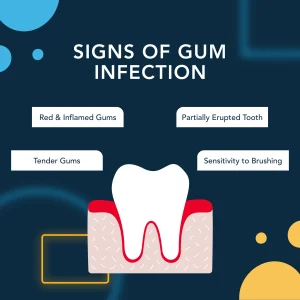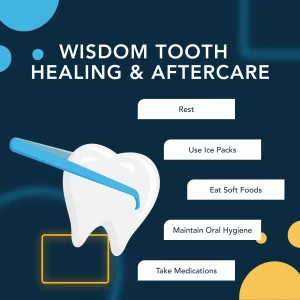What Are Wisdom Teeth?
Wisdom teeth are the third and final set of molars that most people get in their late teens or early twenties. These teeth can be a valuable asset to the mouth when fully erupted and properly aligned, but often, they are misaligned and require removal. Wisdom teeth can become impacted, meaning they are enclosed within the soft tissue of the jawbone or only partially break through the gum, leading to potential gum disease and other oral health problems if they aren’t removed.
Common Signs of a Wisdom Tooth Infection
If you suspect you have a wisdom tooth infection, there are many signs you can look out for. Common signs include redness and swelling of the gums around the tooth, intense pain, pus discharge, difficulty opening the mouth or swallowing, and swollen lymph nodes under the jaw.
Other symptoms may include bad breath, a foul taste in the mouth, and even a fever. Wisdom tooth infections occur when bacteria enter the gums around an impacted wisdom tooth, leading to painful and potentially serious conditions if not treated promptly by a Davie dentist.
Jaw Pain & Swelling
When a wisdom tooth becomes infected, discomfort often extends beyond the tooth itself, manifesting as aching and swelling in the jaw. This inflammation can make it challenging to open the mouth or chew as the area around the infected tooth becomes tender and swollen. The pain may also radiate, causing generalized discomfort throughout the jaw and leading to headaches. These symptoms are indicative of the spread of infection from the wisdom tooth to surrounding tissues, requiring prompt dental attention.
 Gum Pain, Swelling & Sensitivity
Gum Pain, Swelling & Sensitivity
Gum pain, swelling, and sensitivity around a wisdom tooth are often clear signs of infection. The gums may become red, inflamed, and tender to the touch, making brushing and eating uncomfortable. These symptoms arise as the body responds to bacteria trapped around the partially erupted or impacted tooth.
Bleeding or Pus Around the Gums
The presence of bleeding or pus discharge from the gums is a concerning indicator of infection. This condition suggests that bacteria have invaded the gum tissue, leading to an abscess or severe gingivitis. Such symptoms require immediate dental attention to prevent further spread of the infection and alleviate oral pain.
Difficulty Opening Your Mouth & Swallowing
An infection in a wisdom tooth can lead to significant discomfort, including difficulty in opening the mouth and swallowing. This stiffness and pain, often a result of swelling and inflammation in the jaw and surrounding tissues, can severely restrict jaw movement and make even basic oral functions challenging, highlighting the infection’s impact on overall oral mobility and comfort.
Bad Breath or Taste in Your Mouth
Bad breath or a persistent unpleasant taste in your mouth can also be a sign of a wisdom tooth infection. These symptoms typically arise from bacteria accumulating around the infected area, producing foul-smelling gases and substances. Such conditions not only affect your oral hygiene but also indicate the need for immediate dental evaluation and treatment to prevent further complications.
Teeth Crowding
Teeth crowding occurs when there is insufficient space in the jaw to accommodate all the teeth properly, leading to misalignment and overlap. This condition can cause difficulty in cleaning, increase the risk of decay and gum disease, as well as impact oral health and aesthetics. Orthodontic intervention is often necessary to correct the alignment and alleviate dental crowding.
Fever
Experiencing a fever along with tooth pain might indicate a wisdom tooth infection, prompting a visit to a dental clinic in Broward County for evaluation. A fever often indicates that your body is fighting off a bacterial invasion, and this symptom could imply that the infection is severe and may require the extraction of your wisdom teeth to eliminate the source of the infection and prevent further health complications.
What Happens During Wisdom Tooth Surgery?
When undergoing wisdom tooth surgery, the patient is typically given anesthesia to ensure comfort. The oral surgeon then makes an incision in the gum to expose the tooth and bone, removing any bone that blocks access to the tooth root. The tooth may also be divided into sections for easier removal. After extraction, the site is cleaned of debris, and the wound is stitched closed. Finally, gauze is placed over the site to aid clotting. Here’s a further look into what you can expect during wisdom tooth extraction:
Administering the Anesthesia
Administering anesthesia during wisdom tooth surgery is crucial for patient comfort and pain management. Depending on the complexity of the procedure and patient preference, options may include local anesthesia, sedation, or general anesthesia. This ensures a pain-free experience, allowing the surgeon to safely remove the wisdom teeth without causing any discomfort to the patient.
Cutting the Incision
When performing wisdom tooth surgery, the oral surgeon must make a precise incision in the gum tissue to expose the tooth and underlying bone. This step is crucial as it provides direct access to the wisdom tooth, making it easier to remove while minimizing any potential damage to surrounding tissues.
Removing the Tooth
When the surgeon removes the tooth, they must delicately separate it from the surrounding bone and gum tissue. They may choose to section the tooth into smaller pieces to ease extraction and minimize trauma to the area. This process requires skillful handling to ensure complete removal of the tooth while preserving the integrity of the jawbone and adjacent teeth.
Cleaning the Wound
After the wisdom tooth is removed, cleaning the wound is essential to prevent infection and promote healing. During this process, the surgeon meticulously removes any debris, tooth fragments, or bone splinters from the extraction site. This step ensures a clean environment, reduces the risk of complications, and prepares the site for effective closure and healing.
Stitch the Incision
Stitching the incision and closing the gum tissue during wisdom teeth removal is a crucial step for the healing process to begin. The oral surgeon uses sutures that are often dissolvable to help minimize bleeding and protect the wound from infection to facilitate a smoother recovery and quicker return to normal oral function.
Applying Gauze to Stop the Bleeding
To manage bleeding following wisdom tooth surgery, the oral surgeon places gauze over the extraction site, instructing the patient to apply pressure by biting down gently. This simple yet effective method helps to control bleeding and encourages the formation of a blood clot, which is essential for healing. The blood clot acts as a natural barrier, protecting the exposed bone and nerve endings in the empty tooth socket.
Wisdom Tooth Surgery Healing & Aftercare
Following your surgeon’s post-removal guidelines is essential to avoid complications and ensure optimal healing. Key aftercare tips include:
- Rest: Allow your body to heal by avoiding strenuous activities for a few days.
- Ice Packs: Reduce swelling by applying ice packs to the cheek area.
- Soft Foods: Stick to a diet of soft foods to minimize irritation.
- Oral Hygiene: Gently rinse with salt water to keep the area clean.
- Medication: Take prescribed pain relievers and antibiotics as directed.
Adhering to these practices can significantly enhance your healing experience, minimizing discomfort and preventing infection.
Apply Gauze & Pressure
After wisdom tooth surgery, applying gauze and pressure to the extraction site is a crucial initial step in the healing process. This technique helps to control bleeding and encourages the formation of a blood clot, which is vital for proper wound healing. Regularly changing the gauze as directed and maintaining gentle pressure can significantly reduce complications and accelerate the recovery period.
Use Ice Packs to Reduce Swelling
Using ice packs is an effective method to reduce swelling after wisdom tooth extraction. Applying cold packs to the affected area in 20-minute intervals can significantly decrease inflammation and provide relief from discomfort. This simple, non-invasive treatment helps to minimize swelling and improve comfort during the initial healing days.
Avoid Physical Activity for the First Few Days
It’s important to avoid physical activity for the first few days following wisdom tooth removal to ensure optimal healing. Engaging in strenuous activities can increase blood flow to the surgical site, potentially leading to more swelling and bleeding. Resting and limiting movement can significantly reduce the risk of complications, aiding in a smoother and quicker recovery process.
Avoid Spitting or Using a Straw for the First 24 Hours
For the first 24 hours after wisdom tooth surgery, it’s crucial to avoid spitting or using a straw. These actions can dislodge the blood clot forming at the extraction site, which can lead to increased bleeding, delay the healing process, and potentially cause a painful condition known as dry socket, where the protective layer is lost, and the sensitive areas are exposed to air, food, and bacteria.
Rinse Your Mouth With Warm Salt Water
Rinsing your mouth with warm salt water after wisdom tooth surgery is a gentle and effective method to help the healing process. Starting 24 hours post-surgery, this practice helps to clean the extraction site and reduce the risk of infection. The saltwater rinse soothes the area, decreases inflammation, and accelerates recovery, making it a staple in post-operative oral care.
Stick to Softer Foods
After having wisdom teeth removed, it’s important to stick to softer foods to avoid irritating the extraction sites. Soft foods minimize the risk of dislodging the blood clot, which is crucial for healing. Options like yogurt, applesauce, and smoothies are gentle on the mouth and provide necessary nutrition without compromising recovery.
Avoid the Extraction Site While Brushing
Following oral surgery, it’s important to carefully avoid the extraction site while brushing your teeth. This precaution helps prevent irritation and also protects the delicate area during its healing process. Gentle oral hygiene around the site minimizes the risk of dislodging the forming blood clot or introducing bacteria, ensuring a smoother and safer recovery while maintaining overall oral cleanliness
How to Prevent Gum Disease
Preventing gum disease is crucial for maintaining overall oral health and avoiding potential complications that can affect your general well-being. Gum disease, ranging from gingivitis to more severe periodontitis, is primarily caused by plaque buildup, which leads to inflammation, bleeding, and eventually, tooth loss.
By adopting effective oral hygiene practices, making lifestyle adjustments, and seeking regular dental check-ups, you can significantly reduce the risk of developing gum disease. We’ll outline key strategies and habits to implement in your daily routine to ensure your gums stay healthy, strong, and free from disease.
Brush & Floss Twice a Day
Brushing and flossing twice a day are foundational steps in preventing gum disease. This routine removes plaque, the main culprit behind gum inflammation and disease. Regular brushing clears plaque from the tooth surfaces while flossing targets the spaces between teeth and under the gumline, areas where bacteria often accumulate.
Use Fluoride Toothpaste & Mouthwash
Fluoride strengthens tooth enamel, making it more resistant to decay-causing acids from plaque and bacteria. Adding an antibacterial mouthwash to your oral hygiene routine can reduce the overall bacterial load in your mouth, further protecting your gums from inflammation and infection.
Replace Your Toothbrush Every 3 Months
Replacing your toothbrush every three months, or sooner if the bristles become frayed, is essential for preventing gum disease. Over time, toothbrushes lose their efficiency, harboring bacteria and potentially introducing it into your mouth. A fresh toothbrush is more effective at removing plaque and bacteria, which are leading causes of gum inflammation.
Do Not Use Tobacco Products
Tobacco use significantly increases the risk of developing gum conditions, as it impairs blood flow to the gums and weakens the body’s natural defense mechanisms against infection. Moreover, smokers are more likely to form plaque and tartar, which are direct contributors to gum disease, highlighting the importance of avoiding tobacco for oral health.
Eat a Balanced Diet
It’s important to eat a balanced diet that’s rich in vitamins and minerals to prevent gum disease. Many people don’t know this, but foods that are packed with nutrients, especially those high in vitamin C and calcium, can help keep your gums healthy and your teeth strong. On the other hand, if your diet is full of sugary snacks and acidic drinks, it can lead to plaque buildup and bacterial growth, which increases your risk of gum disease.
Schedule Regular Checkups & Cleanings
Scheduling regular checkups and teeth cleanings with your dentist is fundamental to preventing gum disease. These visits allow for the early detection and treatment of potential issues before they escalate. Professional cleanings remove plaque and tartar buildup that daily brushing and flossing can miss, significantly reducing the risk of gum inflammation and disease while ensuring your oral health is maintained.
Drink Lots of Water
Drinking plenty of water throughout the day is beneficial for oral health, as it helps wash away food particles and bacteria that can lead to plaque buildup. Staying hydrated stimulates saliva production, which naturally protects teeth and gums by neutralizing harmful acids and distributing essential minerals throughout the mouth.
Schedule a Dental Checkup in Davie, FL
Routine dental checkups are a proactive step toward maintaining your oral health. Regular dental visits are crucial for early detection of potential issues, professional cleanings, and personalized advice on oral hygiene practices. Your local dentist in Davie, Florida, offers expert professionals equipped to provide comprehensive care, from routine examinations to more specialized treatments. Don’t wait for dental problems to arise; schedule an appointment with a trusted dentist near me.
March 14, 2024

 Adult
Adult



 Gum Pain, Swelling & Sensitivity
Gum Pain, Swelling & Sensitivity